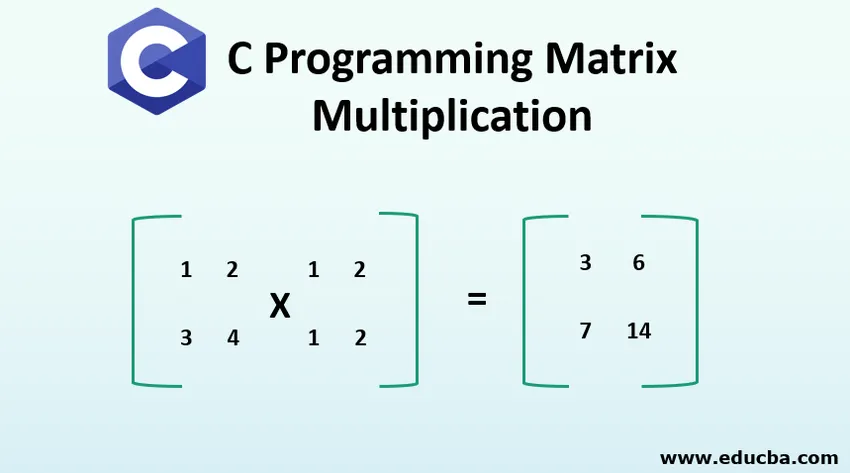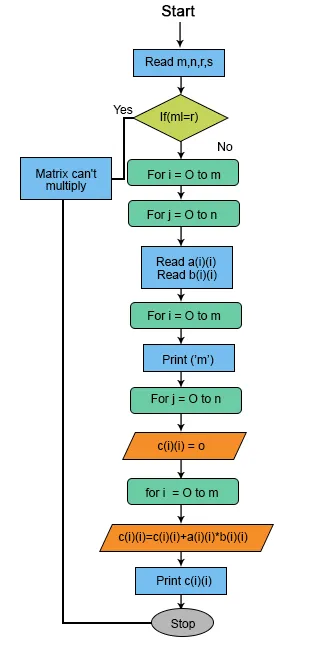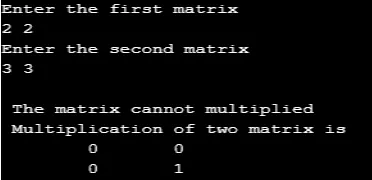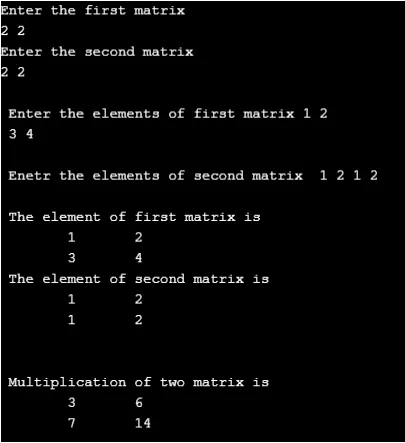
Einführung in die Matrixmultiplikation in der C-Programmierung
In Artikel C Programmieren der Matrixmultiplikation ist eine Matrix ein Raster, in dem Daten in einem strukturierten Format gespeichert werden. Es wird häufig mit einer Tabelle verwendet, in der die Daten in horizontalen Zeilen und vertikalen Spalten dargestellt werden. Matrizen werden häufig in Programmiersprachen verwendet und dienen dazu, die Daten in einer grafischen Struktur darzustellen. Wenn der Benutzer beim Programmieren zwei Matrizen multiplizieren, addieren, subtrahieren und dividieren möchte, sollte zuerst die Reihenfolge der Matrix angegeben werden. Sobald die Reihenfolge der Matrix für die erste und zweite Matrix deklariert ist, müssen die Elemente (Eingaben) für die Matrizen vom Benutzer eingegeben werden. Wenn die Reihenfolge der Matrix nicht proportional zueinander ist, wird die Fehlermeldung angezeigt, die von einem Programmierer in die Bedingungsanweisung eingepflanzt wird. Wenn eine Matrix nur eine Zeile enthält, wird sie als Zeilenvektor bezeichnet, und wenn sie nur eine Spalte enthält, wird sie als Spaltenvektor bezeichnet.
Eine Matrix, die die gleiche Anzahl von Zeilen und Spalten enthält, wird als quadratische Matrix bezeichnet. Matrix wird zum Speichern einer Gruppe zusammengehöriger Daten verwendet. Einige der Programmiersprachen unterstützen Matrizen als Datentyp, der flexibler ist als ein statisches Array. Anstatt die Werte in einer Matrix zu speichern, kann sie als einzelne Variable gespeichert werden, und ein Programm kann effizienter auf die Daten zugreifen und sie bearbeiten. In der C-Programmierung werden Matrixmultiplikationen unter Verwendung von Arrays, Funktionen und Zeigern durchgeführt. Daher werden wir zusammen mit dem Flussdiagramm einen Algorithmus für die Matrixmultiplikation diskutieren, der zum Schreiben von Programmcode für die 3 × 3-Matrixmultiplikation in einer Hochsprache verwendet werden kann. Diese ausführliche Erklärung hilft Ihnen, den Wirkungsmechanismus der Matrixmultiplikation zu analysieren und das Schreiben von Code zu verstehen.
Algorithmus der C-Programmiermatrix-Multiplikation
Schritt 1: Starten Sie das Programm.
Schritt 2: die Zeile und Spalte der ersten (a) Matrix.
Schritt 3: Geben Sie die Zeile und Spalte der zweiten (b) Matrix ein.
Schritt 4: Geben Sie die Elemente der ersten (a) Matrix ein.
Schritt 5: Geben Sie die Elemente der zweiten (b) Matrix ein.
Schritt 6: Drucken Sie die Elemente der ersten (a) Matrix in Matrixform.
Schritt 7: Drucken Sie die Elemente der zweiten (b) Matrix in Matrixform.
Schritt 8: Stellen Sie eine Schleife bis zur Reihe ein.
Schritt 9: Setzen Sie eine innere Schleife bis zur Säule.
Schritt 10: Setzen Sie eine weitere innere Schleife auf die Säule.
Schritt 11: Multiplizieren Sie die erste (a) und zweite (b) Matrix und speichern Sie das Element in der dritten Matrix (c)
Schritt 12: die endgültige Matrix drucken.
Schritt 13: Stoppen Sie das Programm.
Flussdiagramm der Matrixmultiplikation

Beispiel einer C-Programmiermatrix-Multiplikation
Das C-Programm führt eine Matrixmultiplikation durch. Schauen wir uns einige Beispiele an.
Code:
#include
void main()
(
int a(25)(25), b(25)(25), c(25)(25), i, j, k, r, s;
int m, n;
printf("Enter the first matrix\n");
scanf("%d%d", &m, &n);
printf("Enter the second matrix\n");
scanf("%d%d", &r, &s);
if(m!=r)
printf("\n The matrix cannot multiplied");
else
(
printf("\n Enter the elements of first matrix ");
for(i= 0;i (
for(j=0;j scanf("\t%d", &a(i)(j));
)
printf("\n Enetr the elements of second matrix ");
for(i=0;i (
for(j=0;j scanf("\t%d", &b(i)(j));
)
printf("\n The element of first matrix is");
for(i=0;i (
printf("\n");
for(j=0;j printf("\t%d", a(i)(j));
)
printf("\n The element of second matrix is");
for(i=0;i (
printf("\n");
for(j=0;j printf("\t%d", b(i)(j));
)
for(i=0;i (
printf("\n");
for(j=0;j (
c(i)(j)=0;
for(k=0;k c(i)(j)=c(i)(j)+a(i)(k)*b(k)(j);
)
)
)
printf("\n Multiplication of two matrix is");
for(i=0;i (
printf("\n");
for(j=0;j printf("\t%d", c(i)(j));
)
)#include
void main()
(
int a(25)(25), b(25)(25), c(25)(25), i, j, k, r, s;
int m, n;
printf("Enter the first matrix\n");
scanf("%d%d", &m, &n);
printf("Enter the second matrix\n");
scanf("%d%d", &r, &s);
if(m!=r)
printf("\n The matrix cannot multiplied");
else
(
printf("\n Enter the elements of first matrix ");
for(i= 0;i (
for(j=0;j scanf("\t%d", &a(i)(j));
)
printf("\n Enetr the elements of second matrix ");
for(i=0;i (
for(j=0;j scanf("\t%d", &b(i)(j));
)
printf("\n The element of first matrix is");
for(i=0;i (
printf("\n");
for(j=0;j printf("\t%d", a(i)(j));
)
printf("\n The element of second matrix is");
for(i=0;i (
printf("\n");
for(j=0;j printf("\t%d", b(i)(j));
)
for(i=0;i (
printf("\n");
for(j=0;j (
c(i)(j)=0;
for(k=0;k c(i)(j)=c(i)(j)+a(i)(k)*b(k)(j);
)
)
)
printf("\n Multiplication of two matrix is");
for(i=0;i (
printf("\n");
for(j=0;j printf("\t%d", c(i)(j));
)
)#include
void main()
(
int a(25)(25), b(25)(25), c(25)(25), i, j, k, r, s;
int m, n;
printf("Enter the first matrix\n");
scanf("%d%d", &m, &n);
printf("Enter the second matrix\n");
scanf("%d%d", &r, &s);
if(m!=r)
printf("\n The matrix cannot multiplied");
else
(
printf("\n Enter the elements of first matrix ");
for(i= 0;i (
for(j=0;j scanf("\t%d", &a(i)(j));
)
printf("\n Enetr the elements of second matrix ");
for(i=0;i (
for(j=0;j scanf("\t%d", &b(i)(j));
)
printf("\n The element of first matrix is");
for(i=0;i (
printf("\n");
for(j=0;j printf("\t%d", a(i)(j));
)
printf("\n The element of second matrix is");
for(i=0;i (
printf("\n");
for(j=0;j printf("\t%d", b(i)(j));
)
for(i=0;i (
printf("\n");
for(j=0;j (
c(i)(j)=0;
for(k=0;k c(i)(j)=c(i)(j)+a(i)(k)*b(k)(j);
)
)
)
printf("\n Multiplication of two matrix is");
for(i=0;i (
printf("\n");
for(j=0;j printf("\t%d", c(i)(j));
)
)#include
void main()
(
int a(25)(25), b(25)(25), c(25)(25), i, j, k, r, s;
int m, n;
printf("Enter the first matrix\n");
scanf("%d%d", &m, &n);
printf("Enter the second matrix\n");
scanf("%d%d", &r, &s);
if(m!=r)
printf("\n The matrix cannot multiplied");
else
(
printf("\n Enter the elements of first matrix ");
for(i= 0;i (
for(j=0;j scanf("\t%d", &a(i)(j));
)
printf("\n Enetr the elements of second matrix ");
for(i=0;i (
for(j=0;j scanf("\t%d", &b(i)(j));
)
printf("\n The element of first matrix is");
for(i=0;i (
printf("\n");
for(j=0;j printf("\t%d", a(i)(j));
)
printf("\n The element of second matrix is");
for(i=0;i (
printf("\n");
for(j=0;j printf("\t%d", b(i)(j));
)
for(i=0;i (
printf("\n");
for(j=0;j (
c(i)(j)=0;
for(k=0;k c(i)(j)=c(i)(j)+a(i)(k)*b(k)(j);
)
)
)
printf("\n Multiplication of two matrix is");
for(i=0;i (
printf("\n");
for(j=0;j printf("\t%d", c(i)(j));
)
)#include
void main()
(
int a(25)(25), b(25)(25), c(25)(25), i, j, k, r, s;
int m, n;
printf("Enter the first matrix\n");
scanf("%d%d", &m, &n);
printf("Enter the second matrix\n");
scanf("%d%d", &r, &s);
if(m!=r)
printf("\n The matrix cannot multiplied");
else
(
printf("\n Enter the elements of first matrix ");
for(i= 0;i (
for(j=0;j scanf("\t%d", &a(i)(j));
)
printf("\n Enetr the elements of second matrix ");
for(i=0;i (
for(j=0;j scanf("\t%d", &b(i)(j));
)
printf("\n The element of first matrix is");
for(i=0;i (
printf("\n");
for(j=0;j printf("\t%d", a(i)(j));
)
printf("\n The element of second matrix is");
for(i=0;i (
printf("\n");
for(j=0;j printf("\t%d", b(i)(j));
)
for(i=0;i (
printf("\n");
for(j=0;j (
c(i)(j)=0;
for(k=0;k c(i)(j)=c(i)(j)+a(i)(k)*b(k)(j);
)
)
)
printf("\n Multiplication of two matrix is");
for(i=0;i (
printf("\n");
for(j=0;j printf("\t%d", c(i)(j));
)
)#include
void main()
(
int a(25)(25), b(25)(25), c(25)(25), i, j, k, r, s;
int m, n;
printf("Enter the first matrix\n");
scanf("%d%d", &m, &n);
printf("Enter the second matrix\n");
scanf("%d%d", &r, &s);
if(m!=r)
printf("\n The matrix cannot multiplied");
else
(
printf("\n Enter the elements of first matrix ");
for(i= 0;i (
for(j=0;j scanf("\t%d", &a(i)(j));
)
printf("\n Enetr the elements of second matrix ");
for(i=0;i (
for(j=0;j scanf("\t%d", &b(i)(j));
)
printf("\n The element of first matrix is");
for(i=0;i (
printf("\n");
for(j=0;j printf("\t%d", a(i)(j));
)
printf("\n The element of second matrix is");
for(i=0;i (
printf("\n");
for(j=0;j printf("\t%d", b(i)(j));
)
for(i=0;i (
printf("\n");
for(j=0;j (
c(i)(j)=0;
for(k=0;k c(i)(j)=c(i)(j)+a(i)(k)*b(k)(j);
)
)
)
printf("\n Multiplication of two matrix is");
for(i=0;i (
printf("\n");
for(j=0;j printf("\t%d", c(i)(j));
)
)#include
void main()
(
int a(25)(25), b(25)(25), c(25)(25), i, j, k, r, s;
int m, n;
printf("Enter the first matrix\n");
scanf("%d%d", &m, &n);
printf("Enter the second matrix\n");
scanf("%d%d", &r, &s);
if(m!=r)
printf("\n The matrix cannot multiplied");
else
(
printf("\n Enter the elements of first matrix ");
for(i= 0;i (
for(j=0;j scanf("\t%d", &a(i)(j));
)
printf("\n Enetr the elements of second matrix ");
for(i=0;i (
for(j=0;j scanf("\t%d", &b(i)(j));
)
printf("\n The element of first matrix is");
for(i=0;i (
printf("\n");
for(j=0;j printf("\t%d", a(i)(j));
)
printf("\n The element of second matrix is");
for(i=0;i (
printf("\n");
for(j=0;j printf("\t%d", b(i)(j));
)
for(i=0;i (
printf("\n");
for(j=0;j (
c(i)(j)=0;
for(k=0;k c(i)(j)=c(i)(j)+a(i)(k)*b(k)(j);
)
)
)
printf("\n Multiplication of two matrix is");
for(i=0;i (
printf("\n");
for(j=0;j printf("\t%d", c(i)(j));
)
)#include
void main()
(
int a(25)(25), b(25)(25), c(25)(25), i, j, k, r, s;
int m, n;
printf("Enter the first matrix\n");
scanf("%d%d", &m, &n);
printf("Enter the second matrix\n");
scanf("%d%d", &r, &s);
if(m!=r)
printf("\n The matrix cannot multiplied");
else
(
printf("\n Enter the elements of first matrix ");
for(i= 0;i (
for(j=0;j scanf("\t%d", &a(i)(j));
)
printf("\n Enetr the elements of second matrix ");
for(i=0;i (
for(j=0;j scanf("\t%d", &b(i)(j));
)
printf("\n The element of first matrix is");
for(i=0;i (
printf("\n");
for(j=0;j printf("\t%d", a(i)(j));
)
printf("\n The element of second matrix is");
for(i=0;i (
printf("\n");
for(j=0;j printf("\t%d", b(i)(j));
)
for(i=0;i (
printf("\n");
for(j=0;j (
c(i)(j)=0;
for(k=0;k c(i)(j)=c(i)(j)+a(i)(k)*b(k)(j);
)
)
)
printf("\n Multiplication of two matrix is");
for(i=0;i (
printf("\n");
for(j=0;j printf("\t%d", c(i)(j));
)
)#include
void main()
(
int a(25)(25), b(25)(25), c(25)(25), i, j, k, r, s;
int m, n;
printf("Enter the first matrix\n");
scanf("%d%d", &m, &n);
printf("Enter the second matrix\n");
scanf("%d%d", &r, &s);
if(m!=r)
printf("\n The matrix cannot multiplied");
else
(
printf("\n Enter the elements of first matrix ");
for(i= 0;i (
for(j=0;j scanf("\t%d", &a(i)(j));
)
printf("\n Enetr the elements of second matrix ");
for(i=0;i (
for(j=0;j scanf("\t%d", &b(i)(j));
)
printf("\n The element of first matrix is");
for(i=0;i (
printf("\n");
for(j=0;j printf("\t%d", a(i)(j));
)
printf("\n The element of second matrix is");
for(i=0;i (
printf("\n");
for(j=0;j printf("\t%d", b(i)(j));
)
for(i=0;i (
printf("\n");
for(j=0;j (
c(i)(j)=0;
for(k=0;k c(i)(j)=c(i)(j)+a(i)(k)*b(k)(j);
)
)
)
printf("\n Multiplication of two matrix is");
for(i=0;i (
printf("\n");
for(j=0;j printf("\t%d", c(i)(j));
)
)#include
void main()
(
int a(25)(25), b(25)(25), c(25)(25), i, j, k, r, s;
int m, n;
printf("Enter the first matrix\n");
scanf("%d%d", &m, &n);
printf("Enter the second matrix\n");
scanf("%d%d", &r, &s);
if(m!=r)
printf("\n The matrix cannot multiplied");
else
(
printf("\n Enter the elements of first matrix ");
for(i= 0;i (
for(j=0;j scanf("\t%d", &a(i)(j));
)
printf("\n Enetr the elements of second matrix ");
for(i=0;i (
for(j=0;j scanf("\t%d", &b(i)(j));
)
printf("\n The element of first matrix is");
for(i=0;i (
printf("\n");
for(j=0;j printf("\t%d", a(i)(j));
)
printf("\n The element of second matrix is");
for(i=0;i (
printf("\n");
for(j=0;j printf("\t%d", b(i)(j));
)
for(i=0;i (
printf("\n");
for(j=0;j (
c(i)(j)=0;
for(k=0;k c(i)(j)=c(i)(j)+a(i)(k)*b(k)(j);
)
)
)
printf("\n Multiplication of two matrix is");
for(i=0;i (
printf("\n");
for(j=0;j printf("\t%d", c(i)(j));
)
)#include
void main()
(
int a(25)(25), b(25)(25), c(25)(25), i, j, k, r, s;
int m, n;
printf("Enter the first matrix\n");
scanf("%d%d", &m, &n);
printf("Enter the second matrix\n");
scanf("%d%d", &r, &s);
if(m!=r)
printf("\n The matrix cannot multiplied");
else
(
printf("\n Enter the elements of first matrix ");
for(i= 0;i (
for(j=0;j scanf("\t%d", &a(i)(j));
)
printf("\n Enetr the elements of second matrix ");
for(i=0;i (
for(j=0;j scanf("\t%d", &b(i)(j));
)
printf("\n The element of first matrix is");
for(i=0;i (
printf("\n");
for(j=0;j printf("\t%d", a(i)(j));
)
printf("\n The element of second matrix is");
for(i=0;i (
printf("\n");
for(j=0;j printf("\t%d", b(i)(j));
)
for(i=0;i (
printf("\n");
for(j=0;j (
c(i)(j)=0;
for(k=0;k c(i)(j)=c(i)(j)+a(i)(k)*b(k)(j);
)
)
)
printf("\n Multiplication of two matrix is");
for(i=0;i (
printf("\n");
for(j=0;j printf("\t%d", c(i)(j));
)
)#include
void main()
(
int a(25)(25), b(25)(25), c(25)(25), i, j, k, r, s;
int m, n;
printf("Enter the first matrix\n");
scanf("%d%d", &m, &n);
printf("Enter the second matrix\n");
scanf("%d%d", &r, &s);
if(m!=r)
printf("\n The matrix cannot multiplied");
else
(
printf("\n Enter the elements of first matrix ");
for(i= 0;i (
for(j=0;j scanf("\t%d", &a(i)(j));
)
printf("\n Enetr the elements of second matrix ");
for(i=0;i (
for(j=0;j scanf("\t%d", &b(i)(j));
)
printf("\n The element of first matrix is");
for(i=0;i (
printf("\n");
for(j=0;j printf("\t%d", a(i)(j));
)
printf("\n The element of second matrix is");
for(i=0;i (
printf("\n");
for(j=0;j printf("\t%d", b(i)(j));
)
for(i=0;i (
printf("\n");
for(j=0;j (
c(i)(j)=0;
for(k=0;k c(i)(j)=c(i)(j)+a(i)(k)*b(k)(j);
)
)
)
printf("\n Multiplication of two matrix is");
for(i=0;i (
printf("\n");
for(j=0;j printf("\t%d", c(i)(j));
)
)#include
void main()
(
int a(25)(25), b(25)(25), c(25)(25), i, j, k, r, s;
int m, n;
printf("Enter the first matrix\n");
scanf("%d%d", &m, &n);
printf("Enter the second matrix\n");
scanf("%d%d", &r, &s);
if(m!=r)
printf("\n The matrix cannot multiplied");
else
(
printf("\n Enter the elements of first matrix ");
for(i= 0;i (
for(j=0;j scanf("\t%d", &a(i)(j));
)
printf("\n Enetr the elements of second matrix ");
for(i=0;i (
for(j=0;j scanf("\t%d", &b(i)(j));
)
printf("\n The element of first matrix is");
for(i=0;i (
printf("\n");
for(j=0;j printf("\t%d", a(i)(j));
)
printf("\n The element of second matrix is");
for(i=0;i (
printf("\n");
for(j=0;j printf("\t%d", b(i)(j));
)
for(i=0;i (
printf("\n");
for(j=0;j (
c(i)(j)=0;
for(k=0;k c(i)(j)=c(i)(j)+a(i)(k)*b(k)(j);
)
)
)
printf("\n Multiplication of two matrix is");
for(i=0;i (
printf("\n");
for(j=0;j printf("\t%d", c(i)(j));
)
)#include
void main()
(
int a(25)(25), b(25)(25), c(25)(25), i, j, k, r, s;
int m, n;
printf("Enter the first matrix\n");
scanf("%d%d", &m, &n);
printf("Enter the second matrix\n");
scanf("%d%d", &r, &s);
if(m!=r)
printf("\n The matrix cannot multiplied");
else
(
printf("\n Enter the elements of first matrix ");
for(i= 0;i (
for(j=0;j scanf("\t%d", &a(i)(j));
)
printf("\n Enetr the elements of second matrix ");
for(i=0;i (
for(j=0;j scanf("\t%d", &b(i)(j));
)
printf("\n The element of first matrix is");
for(i=0;i (
printf("\n");
for(j=0;j printf("\t%d", a(i)(j));
)
printf("\n The element of second matrix is");
for(i=0;i (
printf("\n");
for(j=0;j printf("\t%d", b(i)(j));
)
for(i=0;i (
printf("\n");
for(j=0;j (
c(i)(j)=0;
for(k=0;k c(i)(j)=c(i)(j)+a(i)(k)*b(k)(j);
)
)
)
printf("\n Multiplication of two matrix is");
for(i=0;i (
printf("\n");
for(j=0;j printf("\t%d", c(i)(j));
)
)
Ausgabe:


Arbeiten mit C Programming Matrix Multiplication
- Im obigen Programm haben wir die Variablen und Arrays innerhalb der main-Methode mit dem Datentyp integer (int) initialisiert.
- Nach dem Initialisierungsteil erhalten wir vom Benutzer die Reihenfolge der Matrix für die erste Matrix, und gleichzeitig muss der Benutzer die Reihenfolge der zweiten Matrix deklarieren.
- Sobald die Reihenfolge der Matrizen deklariert ist und der Bedingungsteil ausgeführt wird, läuft das Programm nur weiter, wenn die Reihenfolge die Bedingung erfüllt, oder das Programm wird an diesem Teil selbst beendet oder gestoppt.
- Sobald die Bedingung erfüllt ist, muss der Benutzer die Matrixelemente zur Laufzeit als Eingaben eingeben.
- Gemäß der Benutzereingabe wird die Matrixmultiplikation berechnet.
- Das obige Matrixprogramm ist einfach und kann Update 25 × 25 berechnen, so dass wir einfach im Array die erforderlichen Zahlen bearbeiten können.
Vorteile der C-Programmiermatrix-Multiplikation
- Die Programmiersprache C unterstützt Matrix als Datentyp und bietet mehr Flexibilität. Außerdem verbraucht es während der Verarbeitung weniger Speicher.
- Durch Speichern von Werten in einer Matrix und nicht als einzelne Variablen kann das C-Programm effizienter auf Daten zugreifen und diese bearbeiten.
- Es ist einfacher, Informationen zur Objektdrehung zu extrahieren und im C-Programm zu bearbeiten.
Fazit
Die Matrixmultiplikation wird in Programmen wiederholt verwendet, um eine grafische Datenstruktur darzustellen, in der mehrere Vektoren gespeichert werden. Sie wird auch in vielen Anwendungen verwendet, z. B. beim Lösen linearer Gleichungen und mehr. Es wurden viele Untersuchungen zur Multiplikation von Matrizen mit einer minimalen Anzahl von Operationen durchgeführt.
Empfohlener Artikel
Dies ist eine Anleitung zur C-Programmiermatrixmultiplikation. Hier diskutieren wir das Arbeiten mit Matrixmanipulation, Algorithmus, Flussdiagramm und Beispielen zusammen mit verschiedenen Vorteilen in der c-Programmierung. Sie können auch unsere anderen Artikelvorschläge durchgehen, um mehr zu erfahren -
- Einführung in Arrays in der C-Programmierung
- Muster in der C-Programmierung - (Beispiele)
- Im Vorstellungsgespräch bei C Programming | Top 13
- Was ist die R-Programmiersprache?
- Arrays in der Datenstruktur